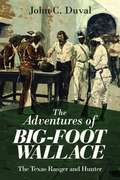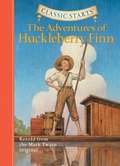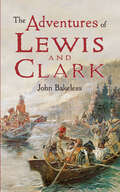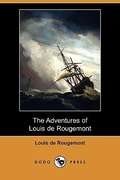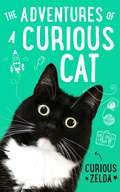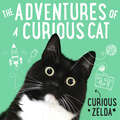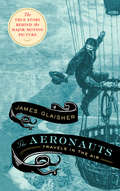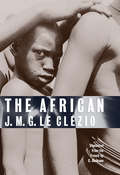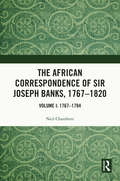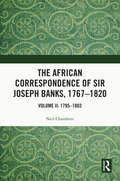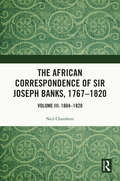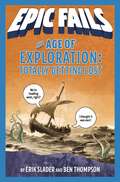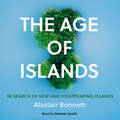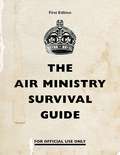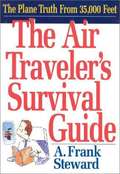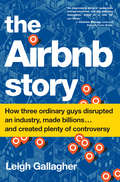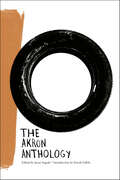- Table View
- List View
The Adventures of Big-Foot Wallace: The Texas Ranger and Hunter
by John C. DuvalThe thrilling adventures of traveler, rancher, and fighter "Big-Foot” Wallace in a bygone era of the American frontier.Amid the embroiling conflicts of frontiersmen, Mexicans, and war in Texas, 1837, William "Big-Foot” Wallace left his hometown of Virginia to avenge the deaths of his brother and cousin, soldiers executed by Mexicans. Upon joining the Texas Rangers, Wallace was swept into the clashes at Salado Creek, Hondo River, and the Battle of Monterrey during the Mexican-American War. Measuring at 6 feet 2 inches tall and weighing 240 pounds, Big-Foot Wallace embodied the iron nerves and indomitable spirit of the Texan frontiersman. In one of his most famous and harrowing experiences during the Mier expedition, Wallace was captured by the Mexican army, blindfolded, and forced to draw from a pot of black and white beans to determine whether he would be imprisoned or executed. Wallace drew a white bean and lived. After the war, he returned from the wilderness to clean, civilized Virginia, and spent the rest of his days as a storytelling, yarn-spinning rancher. John Duval, fellow Texas Ranger and Wallace’s best friend, gives a thrilling but factual account of the man’s life in a simple but engaging narrative style, combining action, suspense, and dry Texan humor. Wallace’s hairbreadth escapes and larger-than-life story are the perfect representation of the Old West in all its perils, comedy, and romance. Skyhorse Publishing, along with our Arcade, Good Books, Sports Publishing, and Yucca imprints, is proud to publish a broad range of biographies, autobiographies, and memoirs. Our list includes biographies on well-known historical figures like Benjamin Franklin, Nelson Mandela, and Alexander Graham Bell, as well as villains from history, such as Heinrich Himmler, John Wayne Gacy, and O. J. Simpson. We have also published survivor stories of World War II, memoirs about overcoming adversity, first-hand tales of adventure, and much more. While not every title we publish becomes a New York Times bestseller or a national bestseller, we are committed to books on subjects that are sometimes overlooked and to authors whose work might not otherwise find a home.
The Adventures of Captain Bonneville
by Washington IrvingThe expeditions and adventures of Captain Bonneville, of the United States army, are the theme of this book.
The Adventures of Huckleberry Finn (Abridged)
by Mark Twain Oliver HoTwain's beloved tale, with its folksy language, creates an indelible image of antebellum America with its sleepy river towns, con men, family feuds, and a variety of colorful characters.
The Adventures of Lewis and Clark (Dover Children's Classics)
by John BakelessIn 1803, when the United States purchased the Louisiana Territory from France (for a scant $15 million), it doubled the size of the young country. Stretching north from New Orleans to the Canadian border and westward from the Mississippi River to the Rocky Mountains, the area contained over 800,000 square miles. That same year, President Thomas Jefferson designated two young men — Meriweather Lewis and William Clark — as leaders of an expedition to explore this vast new acquisition, as well as other lands of the West. In the spring of 1804, the two men and an intrepid band of hunters, carpenters, gunsmiths, and blacksmiths, known as the "Corps of Discovery," embarked on a perilous journey that would truly give meaning to the term "Wild West." In this exciting, action-packed young reader's edition, based on the author's acclaimed earlier study of the two great American explorers, historian John Bakeless chronicles the daily challenges these men faced — from encounters with indigenous people, snake-infested waterways, prairie fires, floods, heat, and thirst, to illness, famine, and frigid mountain passes. The result is a saga of epic proportions, an amazing story of courage and determination sure to delight readers with its authenticity and vivid, dramatic style.
The Adventures of Louis de Rougemont
by Louis De RougemontLouis de Rougemont (1847-1921) was a would-be explorer who claimed to have had adventures in Australasia. "de Rougemont" was born Henri Louis Grin in 1847 in Suchy, Switzerland. <P> <P> In 1898 he began to write about his invented adventures in the British periodical The Wide World Magazine under the name Louis de Rougemont. He described his alleged exploits in search of pearls and gold in New Guinea and claimed to have spent thirty years living with Indigenous Australians in the Australian outback. He claimed that the tribe with whom he had lived had worshipped him as a god. He also claimed to have encountered the Gibson expedition of 1874. Various readers expressed disbelief in his tales from the start, for example, claiming that no one can actually ride a turtle. He had also claimed to have seen flying wombats. The fact that he could not place his travels on the map aroused suspicion. Readers' arguments in the pages of London newspaper, the Daily Chronicle, continued for months.
The Adventures of Robinson Crusoe
by Daniel Defoe"Robinson Crusoe" is about an adventurer who is shipwrecked on a desert island, The book contains adventure of all sorts: pirates, shipwrecks, cannibals, mutiny, and so much more... The book was written by Daniel Defoe and was first published in 1719.
The Adventures of Robinson Crusoe (Great Illustrated Classics)
by Daniel Defoe Malvina G. VogelA great illustrated classics: The Adventures of Robinson Crusoe
The Adventures of a Curious Cat: wit and wisdom from Curious Zelda, purrfect for cats and their humans
by Curious Zelda'A purrfect gift for a loved one with a special affinity for the feline' 'An absolute must for any cat lover''Curiosity is more than a desire to discover. It's a lifestyle, and a purrvilege. It's hours of observing a fly on the wall. It's entering the sock drawer just before it closes. It's sniffing the lampshade one more time . . .'Such is the wisdom of Curious Zelda: social media star, agony aunt, yoga teacher, cat. In The Adventures of a Curious Cat she gives insight into her view of the world and dispenses unparalleled wisdom. Zelda explains, in her unique voice, how to handle humans, how to communicate with furniture, and most importantly how to live a life curiously. It's the ultimate self-help guide for any cat, or indeed, their human.
The Adventures of a Curious Cat: wit and wisdom from Curious Zelda, purrfect for cats and their humans
by Curious Zelda'A purrfect gift for a loved one with a special affinity for the feline''An absolute must for any cat lover''Curiosity is more than a desire to discover. It's a lifestyle, and a purrvilege. It's hours of observing a fly on the wall. It's entering the sock drawer just before it closes. It's sniffing the lampshade one more time . . .'Such is the wisdom of Curious Zelda: social media star, agony aunt, yoga teacher, cat. In The Adventures of a Curious Catshe gives insight into her view of the world and dispenses unparalleled wisdom. Zelda explains, in her unique voice, how to handle humans, how to communicate with furniture, and most importantly how to live a life curiously. It's the ultimate self-help guide for any cat, or indeed, their human.
The Adventures of a Curious Cat: wit and wisdom from Curious Zelda, purrfect for cats and their humans
by Curious Zelda'Curiosity is more than a desire to discover. It's a lifestyle, and a purrvilege. It's hours of observing a fly on the wall. It's entering the sock drawer just before it closes. It's sniffing the lampshade one more time . . .'Such is the wisdom of Curious Zelda: social media star, agony aunt, yoga teacher, cat. In The Adventures of a Curious Cat she gives insight into her view of the world and dispenses unparalleled wisdom. Zelda explains, in her unique voice, how to handle humans, how to communicate with furniture, and most importantly how to live a life curiously. It's the ultimate self-help guide for any cat, or indeed, their human.
The Aeronauts: Travels in the Air
by James GlaisherThe True Story Behind the Major Motion Picture — and one of the greatest daredevil stories in the history of aviationIn 1862, ambitious scientist James Glaisher set out to do the impossible: ascend higher into the skies than ever before. A pioneer of weather forecasting and of photography, and a founding member of the Royal Meteorological Society, he wanted to take ground-breaking research measurements from different altitudes. On 5th September, along with experienced balloonist Henry Coxwell as his pilot, he lifted off in a hot air balloon for what would prove to be a death-defying and historic flight. Rising above the English countryside, they rose to the remarkable height of 37,000 feet (7 miles or 11km), almost killing both men, who experienced blurred vision, loss of motor function and, eventually, unconsciousness. It was a miracle they survived to tell the tale. Written in his own words, The Aeronauts chronicles Glaisher’s incredible flights and discoveries first hand, as well as his observations on those pioneers who came before and inspired him. His audaciously daring journey forms the story of the forthcoming major motion picture The Aeronauts. With an introduction by Professor Liz Bentley, Chief Executive at the Royal Meteorological Society
The Affective Negotiation of Slum Tourism: City Walks in Delhi (Routledge Advances in Tourism and Anthropology)
by Tore HolstEach year, approximately a million tourists visit slum areas on guided tours as a part of their holiday to Asia, Africa or Latin America. This book analyses the cultural encounters that take place between slum tourists and former street children, who work as tour guides for a local NGO in Delhi, India. Slum tours are typically framed as both tourist performances, bought as commodities for a price on the market, and as appeals for aid that tourists encounter within an altruistic discourse of charity. This book enriches the tourism debate by interpreting tourist performances as affective economies, identifying tour guides as emotional labourers and raising questions on the long-term impacts of economically unbalanced encounters with representatives of the Global North, including the researcher. This book studies the ‘feeling rules’ governing a slum tour and how they shape interactions. When do guides permit tourists to exoticise the slum and feel a thrilling sense of disgust towards the effects of abject poverty, and when do they instead guide them towards a sense of solidarity with the slum’s inhabitants? What happens if the tourists rebel and transgress the boundaries delimiting the space of comfortable affective negotiation constituted by the guides? This book will be essential reading for undergraduates, postgraduates and researchers working within the fields of Human Geography, Slum Tourism Research, Subaltern Studies and Development Studies.
The African
by J. M. G. Le ClézioThe African is a short autobiographical account of a pivotal moment in Nobel-Prize-winning author J. M. G. Le Clézio's childhood. In 1948, young Le Clézio, with his mother and brother, left behind a still-devastated Europe to join his father, a military doctor in Nigeria, from whom he'd been separated by the war. In Le Clézio's characteristically intimate, poetic voice, the narrative relates both the dazzled enthusiasm the child feels at discovering newfound freedom in the African savannah and his torment at discovering the rigid authoritarian nature of his father. The power and beauty of the book reside in the fact that both discoveries occur simultaneously.
The African Correspondence of Sir Joseph Banks, 1767–1820: Volume I: 1767–1794
by Neil ChambersThis edition brings together in three fully edited volumes the correspondence and associated papers of Sir Joseph Banks regarding European and especially British exploration of Africa from 1767–1820, for the first time publishing this globally scattered material in one place, thereby revolutionizing its availability and understanding of the activities of a key figure who helped organize and publish a series of missions to penetrate the African interior, mainly from West Africa and by crossing the Sahara from Cairo and Tripoli. Banks was a founder in 1788 of the African Association, which mounted many of these missions, including those of Mungo Park to explore the River Niger, and J.L. Burkhardt exploring Syria, Arabia and Egypt. At the time, little was known about the African interior, its peoples, kingdoms and resources, and the aim of the African Association under Banks was to discover what lay there, to make contact with and study its societies, to map them and their lands and help establish trading links. Banks also maintained a lively correspondence with British diplomatic representatives in North Africa, such as James Mario Matra at Tangier and Henry Salt in Cairo, who were a rich source of news. Moreover, as unofficial director of the royal gardens at Kew he sent pioneering plant collectors to gather plants in South Africa, vastly boosting knowledge of this region’s important flora. At home, he corresponded with politicians, government officials, entrepreneurs, navigators, naturalists and campaigners like William Wilberforce about a great range of issues surrounding Africa. This work is multi-disciplinary and will stand alongside existing series of Banks’s correspondence published by Neil Chambers (Scientific Correspondence, 2007; Indian and Pacific Correspondence, 2007–14). It will appeal to scholars of African history in the Early Modern Period, to those studying exploration and collecting as well as those interested in natural history, the history of science, geography, cartography and the Enlightenment. An Introduction, detailed Calendar of Correspondents, Timelines for each volume and a comprehensive Index supplement the footnotes to nearly 800 documents included in this fascinating and comprehensive new series.
The African Correspondence of Sir Joseph Banks, 1767–1820: Volume II: 1795–1803
by Neil ChambersThis edition brings together in three fully edited volumes the correspondence and associated papers of Sir Joseph Banks regarding European and especially British exploration of Africa from 1767–1820, for the first time publishing this globally scattered material in one place, thereby revolutionizing its availability and understanding of the activities of a key figure who helped organize and publish a series of missions to penetrate the African interior, mainly from West Africa and by crossing the Sahara from Cairo and Tripoli. Banks was a founder in 1788 of the African Association, which mounted many of these missions, including those of Mungo Park to explore the River Niger, and J.L. Burkhardt exploring Syria, Arabia and Egypt. At the time, little was known about the African interior, its peoples, kingdoms and resources, and the aim of the African Association under Banks was to discover what lay there, to make contact with and study its societies, to map them and their lands and help establish trading links. Banks also maintained a lively correspondence with British diplomatic representatives in North Africa, such as James Mario Matra at Tangier and Henry Salt in Cairo, who were a rich source of news. Moreover, as unofficial director of the royal gardens at Kew he sent pioneering plant collectors to gather plants in South Africa, vastly boosting knowledge of this region’s important flora. At home, he corresponded with politicians, government officials, entrepreneurs, navigators, naturalists and campaigners like William Wilberforce about a great range of issues surrounding Africa. This work is multi-disciplinary and will stand alongside existing series of Banks’s correspondence published by Neil Chambers (Scientific Correspondence, 2007; Indian and Pacific Correspondence, 2007–14). It will appeal to scholars of African history in the Early Modern Period, to those studying exploration and collecting as well as those interested in natural history, the history of science, geography, cartography and the Enlightenment. An Introduction, detailed Calendar of Correspondents, Timelines for each volume and a comprehensive Index supplement the footnotes to nearly 800 documents included in this fascinating and comprehensive new series.
The African Correspondence of Sir Joseph Banks, 1767–1820: Volume III 1804–1820
by Neil ChambersThis edition brings together in three fully edited volumes the correspondence and associated papers of Sir Joseph Banks regarding European and especially British exploration of Africa from 1767–1820, for the first time publishing this globally scattered material in one place, thereby revolutionizing its availability and understanding of the activities of a key figure who helped organize and publish a series of missions to penetrate the African interior, mainly from West Africa and by crossing the Sahara from Cairo and Tripoli. Banks was a founder in 1788 of the African Association, which mounted many of these missions, including those of Mungo Park to explore the River Niger, and J.L. Burkhardt exploring Syria, Arabia and Egypt. At the time, little was known about the African interior, its peoples, kingdoms and resources, and the aim of the African Association under Banks was to discover what lay there, to make contact with and study its societies, to map them and their lands and help establish trading links. Banks also maintained a lively correspondence with British diplomatic representatives in North Africa, such as James Mario Matra at Tangier and Henry Salt in Cairo, who were a rich source of news. Moreover, as unofficial director of the royal gardens at Kew he sent pioneering plant collectors to gather plants in South Africa, vastly boosting knowledge of this region’s important flora. At home, he corresponded with politicians, government officials, entrepreneurs, navigators, naturalists and campaigners like William Wilberforce about a great range of issues surrounding Africa. This work is multi-disciplinary and will stand alongside existing series of Banks’s correspondence published by Neil Chambers (Scientific Correspondence, 2007; Indian and Pacific Correspondence, 2007–14). It will appeal to scholars of African history in the Early Modern Period, to those studying exploration and collecting as well as those interested in natural history, the history of science, geography, cartography and the Enlightenment. An Introduction, detailed Calendar of Correspondents, Timelines for each volume and a comprehensive Index supplement the footnotes to nearly 800 documents included in this fascinating and comprehensive new series.
The After-Room
by Maile Meloy Ian SchoenherrIt's 1955, and Benjamin Burrows and Janie Scott are trying to live a safe, normal life in America. It's not easy, when they have the power to prevent nuclear disaster, and sinister forces are circling. Soon the advice of a mysterious, unscrupulous magician propels Janie and Benjamin into danger, and toward the land of the dead. Meanwhile, their friend Jin Lo washes up on a remote island where an American spy is stationed, and finds herself on the trail of a deadly threat in China. But she's on the other side of the world--how can Janie and Benjamin reach her? The triumphant finale in the trilogy that began with Maile Meloy's bestselling, critically acclaimed The Apothecary, and continued in its captivating sequel, The Apprentices, The After-Room is full of enchantment and heart, with Ian Schoenherr's stunning illustrations throughout.From the Hardcover edition.
The Age of Exploration: Totally Getting Lost (Epic Fails #4)
by Ben Thompson Erik SladerChristopher Columbus is one of the most famous explorers of all time, but he was neither the first nor last adventurer to ever stumble upon a great discovery. From the Silk Road of Asia to the icy shores of Antarctica, our knowledge of the world today is in large part due to several intrepid pioneers, risking life and limb for the sake of exploration. After all, setting off into the dark unknown requires an enormous amount of bravery. But every explorer quickly learns that courage and curiosity aren’t enough to save you if you can’t read a map or trespass on somebody else’s land! In this fourth installment of the Epic Fails series, authors Erik Slader and Ben Thompson introduces readers to an international cast of trailblazers and details every mutiny, wrong turn, and undiscovered city of gold behind the age of exploration.
The Age of Islands: In Search of New and Disappearing Islands
by Alastair Bonnett'Extraordinary... A fascinating and intelligent book.' Sunday TimesNew islands are being built at an unprecedented rate whether for tourism or territorial ambition, while many islands are disappearing or fragmenting because of rising sea levels. It is a strange planetary spectacle, creating an ever-changing map which even Google Earth struggles to keep pace with.In The Age of Islands, explorer and geographer Alastair Bonnett takes the reader on a compelling and thought-provoking tour of the world's newest, most fragile and beautiful islands and reveals what, he argues, is one of the great dramas of our time.From a 'crannog', an ancient artificial island in a Scottish loch, to the militarized artificial islands China is building in the South China Sea; from the disappearing islands that remain the home of native Central Americans to the ritzy new islands of Dubai; from Hong Kong and the Isles of Scilly to islands far away and near: all have urgent stories to tell.
The Age of Kali
by William DalrympleFrom the author of The Last Mughal and Nine Lives: the classic stories he gathered during the ten years he spent journeying across the Indian subcontinent, from Sri Lanka and southern India to the North West Frontier of Pakistan. As he searched for evidence of Kali Yug, the "age of darkness" predicted by an ancient Hindu cosmology in a final epoch of strife and corruption, Dalrymple encountered a region that thrilled and surprised him. Venturing to places rarely visited by foreigners, he presents compelling portraits of a diverse range of figures--from a Hindi rap megastar through the Tamil Tigers to the drug lords of Pakistan. Dalrymple's love for the subcontinent comes across in every page, which makes its chronicles of political corruption, ethnic violence and social disintegration all the more poignant. The result is a dark yet vibrant travelogue, and a unique look at a region that continues to be marked by rapid change and unlimited possibilities as it struggles to reconcile the forces of modernity and tradition.
The Air Ministry Survival Guide (Air Ministry Survival Guide)
by AnonTHE ULTIMATE SURVIVAL GUIDE for anyone who thinks they'd survive the world's most hostile environments - or at least imagine they could do.-----------------------------First issued to British airmen in the 1950s the beautifully illustrated Air Ministry Survival Guide provides invaluable practical tips and instruction on how to keep calm and carry on in any hostile environment.Whether you're lost in the desert, arctic, jungle, or adrift on the open ocean, you'll be better off armed with sensible advice on how to:- Build a structurally sound igloo- Pull faces to prevent frostbite (and when to expect bits to fall off should you fail)- Fashion a mask to prevent snowblindness- Make a hat out of seat cushions- Behave in the event of meeting hostile locals- Stay safe from poisonous reptiles and insects- Use a 'fire thong'- Punch man-eating sharks (which are cowards)
The Air Traveler's Survival Guide: The Plane Truth from 35,000 Feet
by A. Frank StewardFrom the Book Jacket: Air travel may be crazy on the ground for passengers, but what's it really like at 35,000 feet for the cabin crew? How safe, for example, are you when you fly? Is airport security as good as they claim? Why are you more susceptible to the effects of alcoholic beverages at 35,000 feet? How common is the "Mile High Club"? Do the South Americans and Scandinavians behave differently in the air? A very Frank Steward answers these questions and countless more in The Air Traveler's Survival Guide, exposing all the warts and blemishes of air travel. You encounter a kaleidoscope of personalities and experiences, including an "enterprising stowaway rat, a woman who discarded all of her clothes, a passenger with a one-way ticket to death, a widow with her husband's ashes, a child who cuts the hair of a sleeping passenger, crew members' fertility problems, itchy and riotous layovers, and mass food poisoning 90 minutes from the nearest airport! Tucked among the 68 stories in The Air Traveler's Survival Guide is a trunkload of tips and advice on how to make the best of air travel, including: What to put in your carry-on bag How to upgrade your seat How to fly standby and save bundles of money How to decipher what crew members say How to minimize the effects of jet lag * How to select a hotel room in which you can sleep Appropriately dedicated to "the people who smile and thank you for your trash," this eye-opening book puts a whole new face on the travel industry. You will laugh and cry and at times grimace, but you'll also discover a rich tapestry of people who populate those crammed seats, crowded aisles, and tiny restrooms. While a lot may go wrong with air travel on the ground and in the air, when you travel with A. Frank Steward, you'll see through the eyes of the cabin crew what air travel is all about - transporting interesting, and often very demanding, strangers from one destination to another.
The Air-Conditioned Nightmare
by Henry MillerIn 1939, after ten years as an expatriate, Henry Miller returned to the United States with a keen desire to see what his native land was really like -- to get to the roots of the American nature and experience. He set out on a journey that was to last for three years, visiting many sections of the country and making friends of all descriptions. "The Air-Conditioned Nightmare" is the result of that odyssey.
The Airbnb Story: How Three Ordinary Guys Disrupted an Industry, Made Billions . . . and Created Plenty of Controversy
by Leigh Gallagher&“An engrossing story of audacious entrepreneurism and big-industry disruption, [this] is a tale for our times.&” —Charles Duhigg, New York Times–bestselling author of The Power of Habit An investigative look into a beloved, disruptive, notorious start-up, this is the remarkable behind-the-scenes story of the creation and growth of Airbnb, the online lodging platform that is now the largest provider of accommodations in the world. At first just the wacky idea of cofounders Brian Chesky, Joe Gebbia, and Nathan Blecharczyk, Airbnb has become indispensable to millions of hosts and travelers around the globe. Fortune editor Leigh Gallagher presents the first nuanced, in-depth look at the Airbnb phenomenon—the successes and controversies alike—and takes us behind the scenes as the company&’s young CEO steers into increasingly uncharted waters. &“A fast-paced, fun dive into one of the seminal firms of our time; through the tale of Airbnb, Leigh Gallagher shows us how the sharing economy can be a force for emotional connection—as well as for social and business disruption.&” —Rana Foroohar, Financial Times columnist and CNN global economic analyst
The Akron Anthology (Belt City Anthologies)
by David Giffels Jason Segedy Joanna RichardsAn evocative collection of essays, poetry, photography and more from some of Akron, Ohio&’s best authors, artists, and activists. Between 1910 and 1920, Akron, Ohio, tripled in size, making it the fastest growing city in the United States. Its period of rapid growth coincided with the expansion of the rubber and tire industry, which in turn corresponded with the automobile boom. But since the mid-1970s, industry has abandoned Akron, and the city has lost thirty-one percent of its population. Once-opulent neighborhoods are now swaths of abandoned homes, and the factories that made Akron the Rubber Capital of the World lie dormant. Edited by Jason Segedy, and bringing together established writers like Rita Dove and David Giffels with the work of emerging voices, The Akron Anthology collects essays, poems, and photographs from the writers, artists, and activists who call Akron home. Here you&’ll find stories that include: The diaries of a doorman The trials and triumphs of refugees who have relocated to the city A portrait of Jamie Stillman, world-renowned effects pedal manufacturer Archie the talking snowman.
